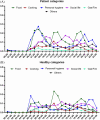The olfactory diary: Tracking awareness and consciousness of the sense of smell throughout the day
- PMID: 38803460
- PMCID: PMC11129550
- DOI: 10.1002/lio2.1268
The olfactory diary: Tracking awareness and consciousness of the sense of smell throughout the day
Abstract
Objectives: The aim of the present study was to follow the daily course of patients with olfactory dysfunction and healthy controls and to assess (i) how many times a day, (ii) at which time, and (iii) in which aspect of daily life participants are conscious about their sense of smell.
Methods: In this longitudinal study, 49 patients with smell loss and 30 healthy participants were enrolled. Olfactory function was assessed using the Sniffin' Sticks. All participants received paper diaries designed for a 14-day period, featuring 12 rows representing 12 daily hours and six columns for various daily life aspects. They were instructed to mark their awareness of smell by indicating the relevant row and column in the diary. Following the return of the diaries, a second olfactory test was conducted within the patient group.
Results: On average, patients were consciously aware of their sense of smell around 8 times daily, while healthy participants noted it about 6.5 times a day. Both groups primarily focused on their sense of smell during activities related to "eating," followed by considerations in "social life" and "personal hygiene." Interestingly, distinct patterns emerged: patients peaked in awareness at 8 a.m. and 7 p.m., whereas healthy individuals showed peaks at 6 a.m., 12 p.m., and 7 p.m. Despite regular diary use, we observed no improvement in patients' olfactory function or related quality of life.
Conclusion: The olfactory diary is a valuable tool unveiling individual smell awareness patterns in patients with smell loss, aiding in counseling and patient management.
Level of evidence: 4.
Keywords: hyposmia; olfaction; olfactory diary; smell; smell loss.
© 2024 The Author(s). Laryngoscope Investigative Otolaryngology published by Wiley Periodicals LLC on behalf of The Triological Society.
Conflict of interest statement
The authors declare that there are no conflicts of interests regarding the publication of this article.
Figures




Similar articles
-
The "Sniffin' Kids-PT" test: A smell test variant for Portuguese children.Eur Ann Otorhinolaryngol Head Neck Dis. 2024 Mar;141(2):69-75. doi: 10.1016/j.anorl.2023.12.003. Epub 2024 Jan 17. Eur Ann Otorhinolaryngol Head Neck Dis. 2024. PMID: 38238186
-
[Clinical application of Sniffin' Sticks olfactory psychophysical measurements].Zhonghua Er Bi Yan Hou Tou Jing Wai Ke Za Zhi. 2013 Sep;48(9):741-5. Zhonghua Er Bi Yan Hou Tou Jing Wai Ke Za Zhi. 2013. PMID: 24330876 Chinese.
-
Olfaction and quality of life in patients with nasal septal deviation treated with septoplasty.Am J Otolaryngol. 2019 Sep-Oct;40(5):747-754. doi: 10.1016/j.amjoto.2019.07.008. Epub 2019 Jul 16. Am J Otolaryngol. 2019. PMID: 31345588
-
Olfactory changes after endoscopic sinus surgery for chronic rhinosinusitis: A meta-analysis.Clin Otolaryngol. 2021 Jan;46(1):41-51. doi: 10.1111/coa.13639. Epub 2020 Sep 23. Clin Otolaryngol. 2021. PMID: 32865350
-
Olfactory Outcomes after Endoscopic Sinus Surgery for Chronic Rhinosinusitis: A Meta-analysis.Otolaryngol Head Neck Surg. 2016 Dec;155(6):936-948. doi: 10.1177/0194599816664879. Epub 2016 Aug 30. Otolaryngol Head Neck Surg. 2016. PMID: 27576679 Review.
References
LinkOut - more resources
Full Text Sources
Research Materials
